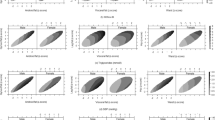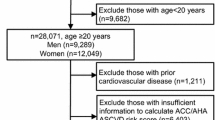Abstract
Purpose
The objective of this study was to determine the independent relationships of trunk fat, leg fat and arm fat to cardiovascular (CVD) risk factors, after controlling for relevant confounders such as fat mass index, cardiorespiratory fitness and objectively measured physical activity.
Methods
This is a cross-sectional study involving 683 university students, aged 18–30 years. Total and regional body fat distribution was measured using dual-energy X-ray absorptiometry. The associations of trunk, leg and arm fat with CVD risk factors (triglycerides-TG-, high-density lipoprotein cholesterol-HDL-c-, TG/HDL-c ratio, HOMAIR, mean arterial pressure, C-reactive protein) were examined using regression linear models, controlling for age, sex, fat mass index [total body fat(kg)/height(m2)], maximal oxygen consumption and physical activity by accelerometer.
Results
After controlling for fat mass index, and other confounders, higher levels of trunk fat were found to be associated with a poorer lipid profile, while higher levels of leg fat were found to be associated with a better lipid profile. We did not find any association between arm fat and lipid profile after controlling for total fatness and other confounders. Neither trunk, leg or arm fat was found to be related to insulin resistance, blood pressure or inflammation markers.
Conclusions
Our data suggest that the region where fat is accumulated might have a differential effect on lipid profile: trunk fat has an adverse effect, leg fat has a protective effect, and arm fat has no effect. The differences observed between upper- and lower-body peripheral fat depots should be further explored.
Similar content being viewed by others
References
Kannel WB, Cupples LA, Ramaswami R, Stokes J III, Kreger BE, Higgins M (1991) Regional obesity and risk of cardiovascular disease; the Framingham Study. J Clin Epidemiol 44:183–190
Arsenault BJ, Lachance D, Lemieux I, Almeras N, Tremblay A, Bouchard C et al (2007) Visceral adipose tissue accumulation, cardiorespiratory fitness, and features of the metabolic syndrome. Arch Intern Med 167:1518–1525
Manolopoulos KN, Karpe F, Frayn KN (2010) Gluteofemoral body fat as a determinant of metabolic health. Int J Obes (Lond) 34:949–959
Vega GL, Adams-Huet B, Peshock R, Willett D, Shah B, Grundy SM (2006) Influence of body fat content and distribution on variation in metabolic risk. J Clin Endocrinol Metab 91:4459–4466
Rocha PM, Barata JT, Teixeira PJ, Ross R, Sardinha LB (2008) Independent and opposite associations of hip and waist circumference with metabolic syndrome components and with inflammatory and atherothrombotic risk factors in overweight and obese women. Metabolism 57:1315–1322
Mason C, Craig CL, Katzmarzyk PT (2008) Influence of central and extremity circumferences on all-cause mortality in men and women. Obesity (Silver Spring) 16:2690–2695
Allison DB, Zhu SK, Plankey M, Faith MS, Heo M (2002) Differential associations of body mass index and adiposity with all-cause mortality among men in the first and second National Health and Nutrition Examination Surveys (NHANES I and NHANES II) follow-up studies. Int J Obes Relat Metab Disord 26:410–416
Zhu S, Heo M, Plankey M, Faith MS, Allison DB (2003) Associations of body mass index and anthropometric indicators of fat mass and fat free mass with all-cause mortality among women in the first and second National Health and Nutrition Examination Surveys follow-up studies. Ann Epidemiol 13:286–293
Tanko LB, Bagger YZ, Alexandersen P, Larsen PJ, Christiansen C (2003) Central and peripheral fat mass have contrasting effect on the progression of aortic calcification in postmenopausal women. Eur Heart J 24:1531–1537
Tanko LB, Bagger YZ, Alexandersen P, Larsen PJ, Christiansen C (2003) Peripheral adiposity exhibits an independent dominant antiatherogenic effect in elderly women. Circulation 107:1626–1631
Ferreira I, Snijder MB, Twisk JW, van Mechelen W, Kemper HC, Seidell JC et al (2004) Central fat mass versus peripheral fat and lean mass: opposite (adverse versus favorable) associations with arterial stiffness? The Amsterdam Growth and Health Longitudinal Study. J Clin Endocrinol Metab 89:2632–2639
Williams MJ, Hunter GR, Kekes-Szabo T, Snyder S, Treuth MS (1997) Regional fat distribution in women and risk of cardiovascular disease. Am J Clin Nutr 65:855–860
Okura T, Nakata Y, Yamabuki K, Tanaka K (2004) Regional body composition changes exhibit opposing effects on coronary heart disease risk factors. Arterioscler Thromb Vasc Biol 24:923–929
Young DR, Steinhardt MA (1993) The importance of physical fitness versus physical activity for coronary artery disease risk factors: a cross-sectional analysis. Res Q Exerc Sport 64:377–384
McMurray RG, Ainsworth BE, Harrell JS, Griggs TR, Williams OD (1998) Is physical activity or aerobic power more influential on reducing cardiovascular disease risk factors? Med Sci Sports Exerc 30:1521–1529
Duncan JJ, Gordon NF, Scott CB (1991) Women walking for health and fitness. How much is enough? JAMA 266:3295–3299
Rizzo NS, Ruiz JR, Hurtig-Wennlof A, Ortega FB, Sjostrom M (2007) Relationship of physical activity, fitness, and fatness with clustered metabolic risk in children and adolescents: the European youth heart study. J Pediatr 150:388–394
Lee DC, Sui X, Ortega FB, Kim YS, Church TS, Winett RA et al (2011) Comparisons of leisure-time physical activity and cardiorespiratory fitness as predictors of all-cause mortality in men and women. Br J Sports Med 45:504–510
Cole TJ, Fewtrell MS, Prentice A (2008) The fallacy of using percentage body fat as a measure of adiposity. Am J Clin Nutr 87(6):1959; author reply 1959–1960
Gallagher D, Ruts E, Visser M, Heshka S, Baumgartner RN, Wang J et al (2000) Weight stability masks sarcopenia in elderly men and women. Am J Physiol Endocrinol Metab 279:E366–E375
Nieman DC, Lasasso H, Austin MD, Pearce S, McInnis T, Unick J (2007) Validation of Cosmed’s FitMate in measuring exercise metabolism. Res Sports Med 15:67–75
Lee J, Bassett DF, Thompson DF, Fitzhugh E (2009) Validation of the Cosmed Fitmate for predicting maximal oxygen consumption: 2185: Board #73 May 28 2:00 PM–3:30 PM. Med Sci Sports Exerc 41:260
Freedson PS, Melanson E, Sirard J (1998) Calibration of the Computer Science and Applications, Inc. accelerometer. Med Sci Sports Exerc 30:777–781
Tabachnick L, Fidell L (2001) Using multivariate statistic, 4th edn. Allyn and Bacon, Boston
Van Pelt RE, Jankowski CM, Gozansky WS, Schwartz RS, Kohrt WM (2005) Lower-body adiposity and metabolic protection in postmenopausal women. J Clin Endocrinol Metab 90:4573–4578
Hunter GR, Kekes-Szabo T, Snyder SW, Nicholson C, Nyikos I, Berland L (1997) Fat distribution, physical activity, and cardiovascular risk factors. Med Sci Sports Exerc 29:362–369
Hunter GR, Chandler-Laney PC, Brock DW, Lara-Castro C, Fernandez JR, Gower BA (2010) Fat distribution, aerobic fitness, blood lipids, and insulin sensitivity in African-American and European-American women. Obesity (Silver Spring) 18:274–281
Terry RB, Stefanick ML, Haskell WL, Wood PD (1991) Contributions of regional adipose tissue depots to plasma lipoprotein concentrations in overweight men and women: possible protective effects of thigh fat. Metabolism 40:733–740
Snijder MB, Dekker JM, Visser M, Bouter LM, Stehouwer CD, Yudkin JS et al (2004) Trunk fat and leg fat have independent and opposite associations with fasting and postload glucose levels: the Hoorn study. Diabetes Care 27:372–377
Yim JE, Heshka S, Albu JB, Heymsfield S, Gallagher D (2008) Femoral-gluteal subcutaneous and intermuscular adipose tissues have independent and opposing relationships with CVD risk. J Appl Physiol 104:700–707
Wannamethee SG, Shaper AG, Lennon L, Whincup PH (2007) Decreased muscle mass and increased central adiposity are independently related to mortality in older men. Am J Clin Nutr 86:1339–1346
Buemann B, Astrup A, Pedersen O, Black E, Holst C, Toubro S et al (2006) Possible role of adiponectin and insulin sensitivity in mediating the favorable effects of lower body fat mass on blood lipids. J Clin Endocrinol Metab 91:1698–1704
Snijder MB, Henry RM, Visser M, Dekker JM, Seidell JC, Ferreira I et al (2004) Regional body composition as a determinant of arterial stiffness in the elderly: the Hoorn study. J Hypertens 22:2339–2347
Nerin I, Crucelaegui A, Novella P, Ramon y Cajal P, Sobradiel N, Gerico R (2004) A survey on the relationship between tobacco use and physical exercise among university students. Arch Bronconeumol 40:5–9
Acknowledgments
We thank all participants of the study. This study was funded mainly by the Foundation for Health Research of Castilla-La Mancha (Fiscam-grant AN-2008/31). Additional funding was obtained from the Spanish Ministry of Education (EX-2008-0641), the Swedish Heart–Lung Foundation (20090635), and Research Network in Preventive and Health Promotion Activities (Red de Investigación en Actividades Preventivas y de Promoción de Salud-RedIAP) (grant RD06/0018/0038).
Conflict of interest
The authors declare that they have not conflict of interest.
Author information
Authors and Affiliations
Corresponding author
Rights and permissions
About this article
Cite this article
Sánchez-López, M., Ortega, F.B., Moya-Martínez, P. et al. Leg fat might be more protective than arm fat in relation to lipid profile. Eur J Nutr 52, 489–495 (2013). https://doi.org/10.1007/s00394-012-0350-4
Received:
Accepted:
Published:
Issue Date:
DOI: https://doi.org/10.1007/s00394-012-0350-4




